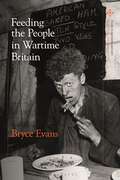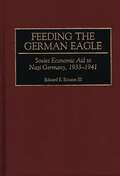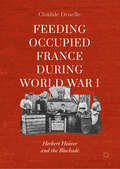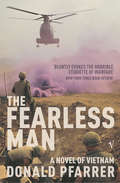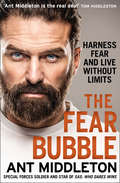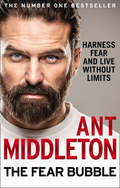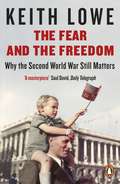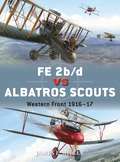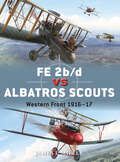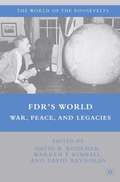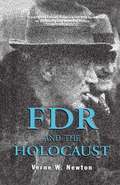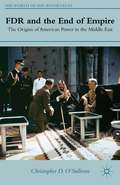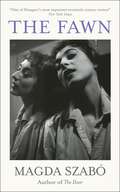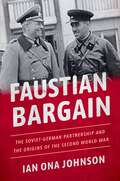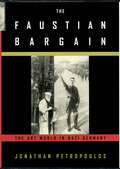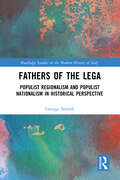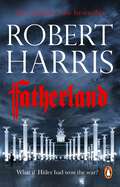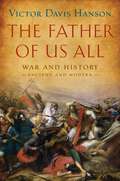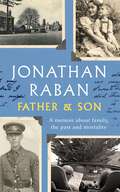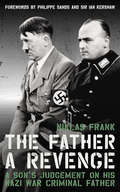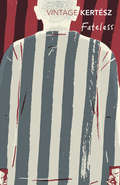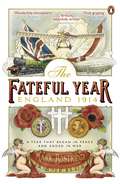- Table View
- List View
Feeding the People in Wartime Britain (Food in Modern History: Traditions and Innovations)
by Bryce EvansWhile the history of food on the home front in wartime Britain has mostly focused on rationing, this book reveals the importance and scale of nation-wide communal dining schemes during this era. Welcomed by some as a symbol of a progressive future in which 'wasteful' home dining would disappear, and derided by others for threatening the social order, these sites of food and eating attracted great political and cultural debate. Using extensive primary source material, Feeding the People in Wartime Britain examines the cuisine served in these communal restaurants and the people who used them. It challenges the notion that communal eating played a marginal role in wartime food policy and reveals the impact they had in advancing nutritional understanding and new food technologies. Comparing them to similar ventures in mainland Europe and understanding the role of propaganda from the Ministry of Food in their success, Evans unearths this neglected history of emergency public feeding and relates it to contemporary debates around food policy in times of crisis.
Feeding the German Eagle: Soviet Economic Aid to Nazi Germany, 1933-1941 (Non-ser.)
by Edward E. IIIThe dramatic story of Hitler and Stalin's marriage of convenience has been recounted frequently over the past 60 years, but with remarkably little consensus. As the first English-language study to analyze the development, extent, and importance of the Nazi-Soviet economic relationship from Hitler's ascension to power to the launching of Operation Barbarossa in June 1941, this book highlights the crucial role that Soviet economic aid played in Germany's early successes in World War II. When Hitler's rearmament efforts left Germany dangerously short of raw materials in 1939, Stalin was able to offer valuable supplies of oil, manganese, grain, and rubber. In exchange, the Soviet Union would gain territory and obtain the technology and equipment necessary for its own rearmament efforts.However, by the summer of 1941, Stalin's well-calculated plan had gone awry. Germany's continuing reliance on Soviet raw materials would, Stalin hoped, convince Hitler that he could not afford to invade the USSR. As a result, the Soviets continued to supply the Reich with the resources that would later carry the Wehrmacht to the gates of Moscow and nearly cost the Soviets the war. The extensive use in this study of neglected source material in the German archives helps resolve the long-standing debate over whether Stalin's foreign policy was one of expansionism or appeasement.
Feeding Occupied France during World War I: Herbert Hoover and the Blockade
by Clotilde DruelleThis book examines the history of Herbert Hoover’s Commission for Relief in Belgium, which supplied humanitarian aid to the millions of civilians trapped behind German lines in Belgium and Northern France during World War I. Here, Clotilde Druelle focuses on the little-known work of the CRB in Northern France, crossing continents and excavating neglected archives to tell the story of daily life under Allied blockade in the region. She shows how the survival of 2.3 million French civilians came to depend upon the transnational mobilization of a new sort of diplomatic actor—the non-governmental organization. Lacking formal authority, the leaders of the CRB claimed moral authority, introducing the concepts of a “humanitarian food emergency” and “humanitarian corridors” and ushering in a new age of international relations and American hegemony.
The Fearless Man: A Novel of Vietnam
by Donald PfarrerThe mission is Vietnam in microcosm: a quest to find and destroy a secret cache of enemy weapons. Leading this fateful journey is Captain MacHugh Clare, a draftee who has become the consummate soldier. Unconcerned with death, each morning he shifts immediately from unconsciousness to action. His reward at the end of the mission is the possibility of seeing his wife. Beside Mac is his opposite. Chaplain Paul Adrano, who knows only doubt and disillusion. He has come to Vietnam to kill his fear, to find his faith again on the field of battle, and he will soon know the forbidden power of violence and the pull of sexual temptation. Meanwhile, in America, Mac's Sarah wife fights her own battle - against a feeling of uselessness. Struggling with notions of a woman's proper role, Sarah begins to see possibilities beyond merely waiting for the man she loves. The Fearless Man is an epic novel of all the wars we wage to occupy ground, forge a future, and save our souls.
The Fear Bubble: How To Harness Fear And Live Without Limits
by Ant MiddletonThe brilliant, inspirational next book by the author of the incredible No. 1 bestseller FIRST MAN IN.
The Fear Bubble: How To Harness Fear And Live Without Limits
by Ant MiddletonThe brilliant, inspirational next book by the author of the incredible No. 1 bestseller FIRST MAN IN.
The Fear and the Freedom: How the Second World War Changed Us
by Keith LoweThe Second World War was one of the most catastrophic events in human history. But how did the experience and memory of bloodshed affect our relationships with each other and the world?The new order, as it emerged after 1945, saw the end of European empires and the birth of two new superpowers, whose wrangling would lead to a new, global Cold War. Scientists delivered new technologies, architects planned buildings to rise from the rubble, politicians fantasized about overhauled societies, people changed their nationalities and dreamed of new lives.As well as analyzing the major changes, The Fear and the Freedom uses the stores of how ordinary people coped with the post-war world and turned one of the greatest traumas in history into an opportunity for change. This is the definitive exploration of the aftermath of WWII - and the impact it still has today on our nations, cities and families.
FE 2b/d vs Albatros Scouts: Western Front 1916–17 (Duel)
by Jim Laurier Mark Postlethwaite James F. MillerIn the spring of 1916 the deployment of the RFC's FE 2 – with its rotary engine 'pusher' configuration affording excellent visibility for its pilot and observer, and removing the need for synchronized machine guns – helped wrest aerial dominance from Imperial Germany's Fokker Eindecker monoplanes, and then contributed to retaining it throughout the Somme battles of that fateful summer. However, by autumn German reorganization saw the birth of the Jagdstaffeln (specialised fighter squadrons) and the arrival of the new Albatros D scout, a sleek inline-engined machine built for speed and twin-gun firepower. Thus, for the remainder of 1916 and well into the next year an epic struggle for aerial superiority raged above the horrors of the Somme and Passchendaele battlefields, pitting the FE 2 against the better-armed and faster Albatros scouts that were focused on attacking and destroying their two-seater opponents. In the end the Germans would regain air superiority, and hold it into the following summer with the employment of their new Jagdgeschwader (larger fighter groupings), but the FE 2 remained a tenacious foe that inflicted many casualties – some of whom were Germany's best aces (including 'The Red Baron').
FE 2b/d vs Albatros Scouts: Western Front 1916–17 (Duel #55)
by James F. MillerIn the spring of 1916 the deployment of the RFC's FE 2 – with its rotary engine 'pusher' configuration affording excellent visibility for its pilot and observer, and removing the need for synchronized machine guns – helped wrest aerial dominance from Imperial Germany's Fokker Eindecker monoplanes, and then contributed to retaining it throughout the Somme battles of that fateful summer. However, by autumn German reorganization saw the birth of the Jagdstaffeln (specialised fighter squadrons) and the arrival of the new Albatros D scout, a sleek inline-engined machine built for speed and twin-gun firepower. Thus, for the remainder of 1916 and well into the next year an epic struggle for aerial superiority raged above the horrors of the Somme and Passchendaele battlefields, pitting the FE 2 against the better-armed and faster Albatros scouts that were focused on attacking and destroying their two-seater opponents. In the end the Germans would regain air superiority, and hold it into the following summer with the employment of their new Jagdgeschwader (larger fighter groupings), but the FE 2 remained a tenacious foe that inflicted many casualties – some of whom were Germany's best aces (including 'The Red Baron').
FDR's World: War, Peace, and Legacies (The World of the Roosevelts)
by D. Woolner W. Kimball D. ReynoldsThis volume assesses Franklin Roosevelt's role as war leader from the vantage point of the twenty-first century, by looking at different aspects of his foreign policy.
FDR and the Holocaust (The World of the Roosevelts)
by NA NAThe contributors to this volume take a hard look at Roosevelt's reaction to the Holocaust.
FDR and the End of Empire: The Origins of American Power in the Middle East (The World of the Roosevelts)
by C. O'SullivanBased upon extensive archival research in Great Britain, the United States, and the Middle East, including sources never previously utilized such as declassified intelligence records, postwar planning documents, and the personal papers of key officials, this is painstakingly researched account of the origins of American involvement in the Middle East during the Presidency of Franklin D. Roosevelt. It explores the effort to challenge British and French power, and the building of new relationships with Iraq, Iran, Saudi Arabia, Egypt, and the Levant states. It also reveals new and controversial discoveries about Roosevelt's views on Palestine, his relations with Middle East leaders, and his often bitter conflicts with Churchill and de Gaulle over European imperialism. Modern-day parallels make this story compelling for followers of current events, World War II, Franklin Roosevelt, the Middle East, or British imperialism.
The Fawn
by Magda Szabó"One of Hungary's most important twentieth-century writers" New York Times"Magda Szabó's fiction shows the travails of modern Hungarian history from oblique but sharply illuminating angles" EconomistEszter Encsy is an acclaimed actress, funny and outrageous, quick-witted but callous. Yet even flushed with the success of adulthood, Eszter craves acceptance of herself as she really is and of the person she has been. The only child of an impoverished aristocrat and a harried music teacher failing to make ends meet, Eszter grew up poor and painfully aware of it in a provincial Hungarian town.The feelings of resentment and envy acquired during her fraught childhood have hardened into an obsessional hatred for one person, the beautiful, saintly and pampered Angéla, Eszter's former classmate and the wife of the man who becomes her lover. Set against newly communist 1950s Hungary, The Fawn embraces the lies and falsehoods people were obliged to live with in those nightmarish times, and displays Szabó's uncanny ability to convey how the past can haunt and consume us.Translated from the Hungarian by Len Rix.
Faustian Bargain: The Soviet-German Partnership and the Origins of the Second World War
by Ian Ona JohnsonWhen Nazi Germany invaded Poland on September 1, 1939, launching World War Two, its army seemed an unstoppable force. The Luftwaffe bombed towns and cities across the country, and fifty divisions of the Wehrmacht crossed the border. Yet only two decades earlier, at the end of World War One, Germany had been an utterly and abjectly defeated military power. Foreign troops occupied its industrial heartland and the Treaty of Versailles reduced the vaunted German army of World War One to a fraction of its size, banning it from developing new military technologies. When Hitler came to power in 1933, these strictures were still in effect. By 1939, however, he had at his disposal a fighting force of 4.2 million men, armed with the most advanced weapons in the world. How could this nearly miraculous turnaround have happened? The answer lies in Russia. Beginning in the years immediately after World War One and continuing for more than a decade, the German military and the Soviet Union--despite having been mortal enemies--entered into a partnership designed to overturn the order in Europe. Centering on economic and military cooperation, the arrangement led to the establishment of a network of military bases and industrial facilities on Soviet soil. Through their alliance, which continued for over a decade, Germany gained the space to rebuild its army. In return, the Soviet Union received vital military, technological and economic assistance. Both became, once again, military powers capable of a mass destruction that was eventually directed against one another. Drawing from archives in five countries, including new collections of declassified Russian documents, The Faustian Bargain offers the definitive exploration of a shadowy but fateful alliance.
Faustian Bargain: The Soviet-German Partnership and the Origins of the Second World War
by Ian Ona JohnsonWhen Nazi Germany invaded Poland on September 1, 1939, launching World War Two, its army seemed an unstoppable force. The Luftwaffe bombed towns and cities across the country, and fifty divisions of the Wehrmacht crossed the border. Yet only two decades earlier, at the end of World War One, Germany had been an utterly and abjectly defeated military power. Foreign troops occupied its industrial heartland and the Treaty of Versailles reduced the vaunted German army of World War One to a fraction of its size, banning it from developing new military technologies. When Hitler came to power in 1933, these strictures were still in effect. By 1939, however, he had at his disposal a fighting force of 4.2 million men, armed with the most advanced weapons in the world. How could this nearly miraculous turnaround have happened? The answer lies in Russia. Beginning in the years immediately after World War One and continuing for more than a decade, the German military and the Soviet Union--despite having been mortal enemies--entered into a partnership designed to overturn the order in Europe. Centering on economic and military cooperation, the arrangement led to the establishment of a network of military bases and industrial facilities on Soviet soil. Through their alliance, which continued for over a decade, Germany gained the space to rebuild its army. In return, the Soviet Union received vital military, technological and economic assistance. Both became, once again, military powers capable of a mass destruction that was eventually directed against one another. Drawing from archives in five countries, including new collections of declassified Russian documents, The Faustian Bargain offers the definitive exploration of a shadowy but fateful alliance.
The Faustian Bargain: The Art World in Nazi Germany
by Jonathan PetropoulosNazi art looting has been the subject of enormous international attention in recent years, and the topic of two history bestsellers, Hector Feliciano's The Lost Museum and Lynn Nicholas's The Rape of Europa. But such books leave us wondering: What made thoughtful, educated, artistic men and women decide to put their talents in the service of a brutal and inhuman regime? This question is the starting point for The Faustian Bargain, Jonathan Petropoulos's study of the key figures in the art world of Nazi Germany. Petropoulos follows the careers of these prominent individuals who like Faust, that German archetype, chose to pursue artistic ends through collaboration with diabolical forces. Readers meet Ernst Buchner, the distinguished museum director and expert on Old Master paintings who "repatriated" the Van Eyck brother's Ghent altarpiece to Germany, and Karl Haberstock, an art dealer who filled German museums with works bought virtually at gunpoint from Jewish collectors. Robert Scholz, the leading art critic in the Third Reich, became an officer in the chief art looting unit in France and Kajetan Muhlmann--a leading art historian--was probably the single most prolific art plunderer in the war (and arguably in history). Finally, there is Arno Breker, a gifted artist who exchanged his modernist style for monumental realism and became Hitler's favorite sculptor. If it is striking that these educated men became part of the Nazi machine, it is more remarkable that most of them rehabilitated their careers and lived comfortably after the war. Petropoulos has discovered a network of these rehabilitated experts that flourished in the postwar period, and he argues that this is a key to the tens of thousands of looted artworks that are still "missing" today. Based on previously unreleased information and recently declassified documents, The Faustian Bargain is a gripping read about the art world during this period, and a fascinating examination of the intense relationship between culture and politics in the Third Reich.
The Faustian Bargain: The Art World in Nazi Germany
by Jonathan PetropoulosNazi art looting has been the subject of enormous international attention in recent years, and the topic of two history bestsellers, Hector Feliciano's The Lost Museum and Lynn Nicholas's The Rape of Europa. But such books leave us wondering: What made thoughtful, educated, artistic men and women decide to put their talents in the service of a brutal and inhuman regime? This question is the starting point for The Faustian Bargain, Jonathan Petropoulos's study of the key figures in the art world of Nazi Germany. Petropoulos follows the careers of these prominent individuals who like Faust, that German archetype, chose to pursue artistic ends through collaboration with diabolical forces. Readers meet Ernst Buchner, the distinguished museum director and expert on Old Master paintings who "repatriated" the Van Eyck brother's Ghent altarpiece to Germany, and Karl Haberstock, an art dealer who filled German museums with works bought virtually at gunpoint from Jewish collectors. Robert Scholz, the leading art critic in the Third Reich, became an officer in the chief art looting unit in France and Kajetan Muhlmann--a leading art historian--was probably the single most prolific art plunderer in the war (and arguably in history). Finally, there is Arno Breker, a gifted artist who exchanged his modernist style for monumental realism and became Hitler's favorite sculptor. If it is striking that these educated men became part of the Nazi machine, it is more remarkable that most of them rehabilitated their careers and lived comfortably after the war. Petropoulos has discovered a network of these rehabilitated experts that flourished in the postwar period, and he argues that this is a key to the tens of thousands of looted artworks that are still "missing" today. Based on previously unreleased information and recently declassified documents, The Faustian Bargain is a gripping read about the art world during this period, and a fascinating examination of the intense relationship between culture and politics in the Third Reich.
Fathers of the Lega: Populist Regionalism and Populist Nationalism in Historical Perspective (Routledge Studies in the Modern History of Italy)
by George NewthThis book investigates the historical roots of the Italian Republic’s oldest surviving political party, the populist far right Lega (Nord), tracing its origins to post-war Italy. The author examines two main case studies: the Movements for Regional Autonomy (MRAs), the Piedmontese Movement for Regional Autonomy (the MARP) and the Bergamascan Movement for Autonomy (the MAB), both of which formed a first wave of post-war populist regionalism from 1955 until 1960. The regionalist leagues which later emerged in both Piedmont and Lombardy in the 1980s – and which would later form part of the Lega Nord – represented in many ways a revival of the MRAs’ populist regionalist discourse and ideology and, therefore, a second wave of post-war populist regionalism. Despite this, neither the MRAs nor the twenty year gap between these waves of activism have received the attention they deserve. Drawing on a series of archival and secondary sources this book takes an innovative approach which blends concepts and theories from historical sociology and political science. It also provides a nuanced examination of the continuities and discontinuities between the MRAs and the Lega from the 1950s until time of publication. This contributes to debates not only in contemporary Italian history, but also populism and the far right. While rooted in historical approaches, the book’s interdisciplinarity makes it suitable for students and researchers across a variety of subject areas including European history, modern history, and political history.
Fathers of the Lega: Populist Regionalism and Populist Nationalism in Historical Perspective (Routledge Studies in the Modern History of Italy)
by George NewthThis book investigates the historical roots of the Italian Republic’s oldest surviving political party, the populist far right Lega (Nord), tracing its origins to post-war Italy. The author examines two main case studies: the Movements for Regional Autonomy (MRAs), the Piedmontese Movement for Regional Autonomy (the MARP) and the Bergamascan Movement for Autonomy (the MAB), both of which formed a first wave of post-war populist regionalism from 1955 until 1960. The regionalist leagues which later emerged in both Piedmont and Lombardy in the 1980s – and which would later form part of the Lega Nord – represented in many ways a revival of the MRAs’ populist regionalist discourse and ideology and, therefore, a second wave of post-war populist regionalism. Despite this, neither the MRAs nor the twenty year gap between these waves of activism have received the attention they deserve. Drawing on a series of archival and secondary sources this book takes an innovative approach which blends concepts and theories from historical sociology and political science. It also provides a nuanced examination of the continuities and discontinuities between the MRAs and the Lega from the 1950s until time of publication. This contributes to debates not only in contemporary Italian history, but also populism and the far right. While rooted in historical approaches, the book’s interdisciplinarity makes it suitable for students and researchers across a variety of subject areas including European history, modern history, and political history.
Fatherland (Mortalis Ser.)
by Robert HarrisPRE-ORDER PRECIPICE, THE THRILLING NEW NOVEL FROM ROBERT HARRIS, NOW - PUBLISHING AUGUST 2024'A writer who handles suspense like a literary Alfred Hitchcock' Nelson MandelaApril, 1964. The naked body of an old man floats in a lake on the outskirts of Berlin. In one week it will be Adolf Hitler's 75th birthday. A terrible conspiracy is starting to unravel . . .'Robert Harris has created the whole structure of a totally corrupt society in a way that makes the flesh creep' Sunday Times'Powerful and chilling . . . convincing in every detail' Daily Telegraph'Clever and ingenious . . . its breeding is by Orwell, out of P.D. James, a detective story inside a future shock' Daily Mail
The Father of Us All: War and History, Ancient and Modern
by Victor Davis HansonVictor Davis Hanson has long been acclaimed as one of our leading scholars of ancient history. In recent years he has also become a trenchant voice on current affairs, bringing a historian's deep knowledge of past conflicts to bear on the crises of the present, from 9/11 to Iran. "War," he writes, "is an entirely human enterprise." Ideologies change, technologies develop, new strategies are invented-but human nature is constant across time and space. The dynamics of warfare in the present age still remain comprehensible to us through careful study of the past. Though many have called the War on Terror unprecedented, its contours would have been quite familiar to Themistocles of Athens or William Tecumseh Sherman. And as we face the menace of a bin Laden or a Kim Jong-Il, we can prepare ourselves with knowledge of how such challenges have been met before.The Father of Us All brings together much of Hanson's finest writing on war and society, both ancient and modern. The author has gathered a range of essays, and combined and revised them into a richly textured new work that explores such topics as how technology shapes warfare, what constitutes the "American way of war," and why even those who abhor war need to study military history. "War is the father and king of us all," Heraclitus wrote in ancient Greece. And as Victor Davis Hanson shows, it is no less so today.
Father and Son: A memoir about family, the past and mortality
by Jonathan Raban'A beautiful, compelling memoir . . . Father and Son is an exquisite, sometimes lunatic tension between powerful emotions and carnage on one side, and on the other, the conventional codes of what must remain unsaid. This, Raban's final work, is a gorgeous achievement" – Ian McEwanOn 11 June 2011, three days short of his sixty-ninth birthday, Jonathan Raban suffered a stroke which left him unable to use the right side of his body. Learning to use a wheelchair in a rehab facility outside Seattle and resisting the ministrations of the nurses overseeing his recovery, Raban began to reflect upon the measure of his own life in the face of his own mortality. Together with the chronicle of his recovery is the extraordinary story of his parents’ marriage, the early years of which were conducted by letter while his father fought in the Second World War.Jonathan Raban engages profoundly and candidly with some of the biggest questions at the heart of what it means to be alive, laying bare the human capacity to withstand trauma, as well as the warmth, strength, and humour that persist despite it. Father and Son, the final work from the peerless man of letters, is a tremendous, continent-sweeping story of love and resilience in the face of immense loss.
The Father: A son's judgement on his Nazi war criminal father
by Niklas FrankNiklas Frank was just seven years old when his father, Hans Frank, Hitler’s legal adviser and Governor General of occupied Poland, was executed at Nuremberg as a Nazi war criminal. Throughout his life, Niklas has attempted to come to terms with the enormity of the crimes his father committed, and this remarkable book traces how after years of research he uncovered the extent of the horror unleashed by the man who was known as the butcher of Poland.The Father is an extraordinary account of a scarred son struggling to comprehend the depravity of the acts that were committed by his father. Whereas other descendants of Hitler’s henchmen and co-collaborators have tried to explain or to forget the crimes of their forebears, Niklas’s disgust for his father’s actions is unremitting. This book is his attempt to seek revenge.Featuring forewords by Philippe Sands and Sir Ian Kershaw, The Father is by turns shocking, twisted and heart-rending; a devastating settling of accounts written by a son addressing his father as he pictures him burning in the eternal fires of hell.
Fateless
by Imre Kertesz'While the average reader cannot pretend truly to understand the reality of those who suffered in concentration camps, Kertesz draws us one step closer' ObserverGyuri, a fourteen-year-old Hungarian Jew, gets the day off school to witness his father signing over the family timber business - his final act before being sent to a labour camp. Two months later, Gyuri finds himself assigned to a 'permanent workplace'. This is the start of his journey to Auschwitz.On his arrival Gyuri finds that he is unable to identify with other Jews, and is rejected by them. An outsider among his own people, his estrangement makes him a preternaturally acute observer, dogmatically insisting on making sense of the barbarity - and beauty - he witnesses.
The Fateful Year: England 1914
by Mark BostridgeThe Fateful Year is the story of England in 1914. War with Germany, so often imagined and predicted, finally broke out when people were least prepared for it. Here, among a crowded cast of unforgettable characters, are suffragettes, armed with axes, and celebrity aviators thrilling spectators by looping the loop. With the coming of war, England is beset by spy hysteria and fears of invasion. Patriotic women hand out white feathers to men who have failed to rush to their country's defence. And as 1914 fades out, England prepares itself for the prospect of a war of long duration.
